Art Centres play a vital role in Aboriginal communities,
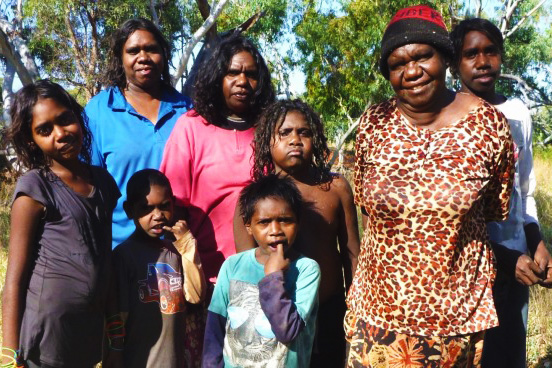
Ampilatwatja Artists
Location: 320 kms north of Alice Springs
Region: Central Desert, Northern Territory
Ampilatwatja community is centrally located on Alyawarr lands along the Sandover Highway north from Alice Springs. Ammaroo station was created here in 1940 and land was later excised to build the community in mid-1980s and to create small land holdings for Alyawarr people during the 1990s. The Alyawarr people have traditional lands that spread over an area of 17,000 sq km on various pastoral leases.
Ampilatwatja Art Centre was established in 1999 and local artists have developed specific style of painting Apmer or country that respects Alyawarr lore. The community made a strong decision not to paint Altyerr or Dreaming stories. They have focused on the natural landscape as the location where the Dreaming stories are played out. By representing the country with fine dot painting the artists show the country from a high vantage point that suggests the connections to Aboriginal culture. Special attention is paid to all aspects of the natural world including plants, bush medicine and bush tucker sources, animal life and waterholes and the connection to country ‘beyond’ the horizon.
Each artist paints the country belonging to their family group as a means of mapping country and connection to country. The paintings are inspired by the experience of the land made special by the fine dot work and rich colour palette used by Ampilatwatja artists.
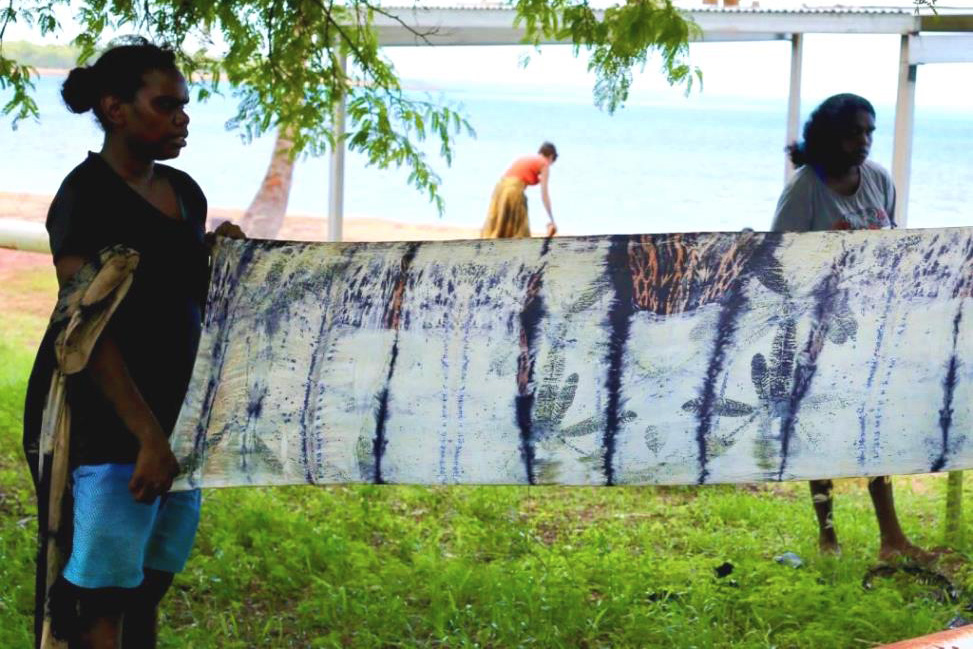
Anindilyakwa Art
Location: Groote Eylandt
Region: East Arnhem Land, Northern Territory
Anindilyakwa Art is the art marketing centre for Indigenous people on Groote Eylandt, off the East Arnhem Land coast of northern Australia. It serves about 2,000 people who live in three main communities and smaller outstations.
Anindilyakwa Art has recently established a textile art program for women artists, who traditionally do not own art practice in their own culture. By combining aspects of culture that the women do manage, the textile project has produced some beautiful results. They have concentrated on dying and weaving skills of the women and incorporated their strong knowledge of native plants. These craft skills come from making baskets and bags and ceremonial artefacts. Now the artists are using natural dyes and found objects and plant materials to make bush-dyed textiles.
The blue-black tones of manganese, which is found widely on the island, feature in many of the colour dyes, designed to highlight the organic, nature-based images used by the artists. These are dyed onto silk, cotton and wool based fabrics. The artists range in age from 18 to 70 years and in the first years about 50 artists have participated in the project.
All products are hand dyed, heated in drums of boiling dye over wood fires in the open air. Artists are developing their own styles of design, using botanical or man-made shapes in their designs, while arranging the elements with varying degrees of random or symmetrical layouts. The art practice is rewarding the artists with their own cultural identity as well as a financial return. Anindilyakwa is participating in a wider movement for handmade organic textiles made in Indigenous communities.
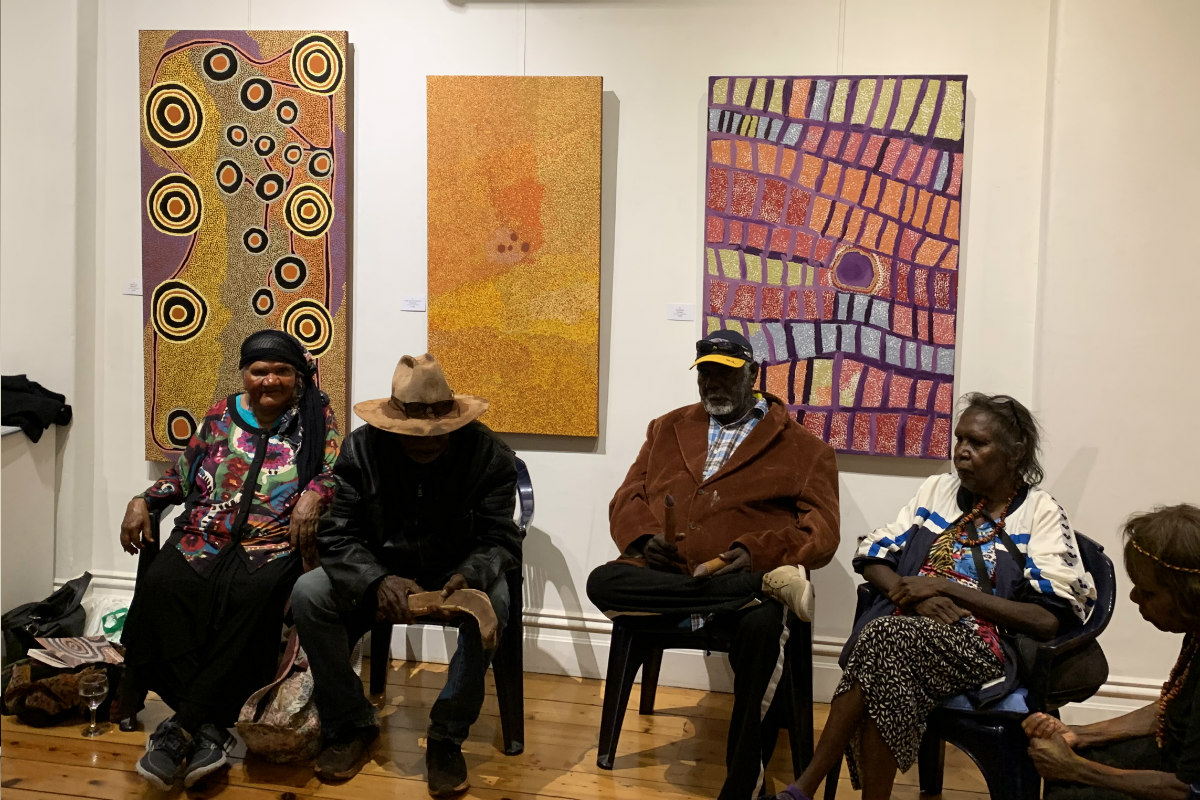
Balgo Artists - Warlayirti
Location: Balgo
Region: Western Australia
Wirrimanu Aboriginal Community at Balgo began as a Catholic Pallottine mission in 1937 and moved twice before settling at the Balgo site in 1965. Its location on the perimeters of the Tanami and Great Sandy Deserts places it 280 kms south of Halls Creek and 810 kms north-west of Alice Springs. Located on the Luurnpa ancestral kingfisher Tjukurrpa or Dreaming track, Balgo in the mid 1970s had a population over 1000 people. After dirt roads were established linking Balgo to other outstations and towns, the population halved as people spread out to other settlements.
Art production had begun in the 1970s and in 1986 anthropologists Ronald and Catherine Berndt with curator John Stanton organised the first major showing of 105 paintings under the title ‘Art from the Great Sandy Desert’. It was held at the Art Gallery of Western Australia where Michael O’Ferrall was Aboriginal Art curator. Thirty four artists exhibited including Eubena Nampitjin, Wimmitji Tjapangarti, Sunfly Tjampitjin, Patrick Tjungurrayi, John Mosquito Tjapangarti, and Tjumpo Tjapanangka. The preface by the Berndts describes ‘a selection of paintings and drawings of great aesthetic significance. All of this work is contemporary. It is also uniquely Aboriginal, distinct in the Balgo style.’
Warlayirti Artists centre was established in 1987 and the work continued to develop a distinctive Balgo style based on Tjukurrpa sites and waterhole locations belonging to different family groups. The iconography is developed from three sources – ritual designs related to ceremonies, pictographs from secular storytelling in sand paintings, and rock paintings. In 1998 a large iron-clad art centre was built in Balgo which has enhanced the art activity for Warlayirti Artists.
Today the next generation of artists carry on the tradition made strong by their elders. Senior artists include Helicopter Joey Tjungurrayi, Ningie Nagala, Lucy Loomoo and Imelda Yukenbarri Guguman. Younger artists include Melissa and Pauline Sunfly, Christine Yukenbarri, Patsy and Marie Mudgedell, Matthew West, Geraldine Nowee and Elizabeth Gordon.
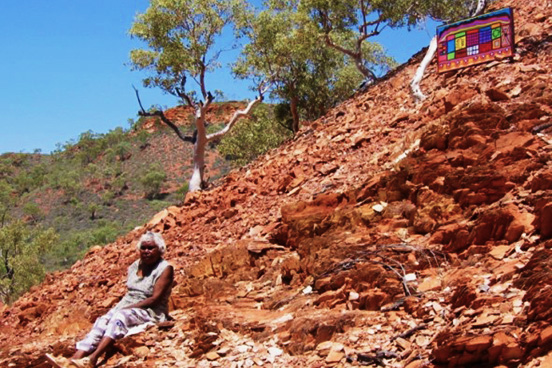
Barkly Arts
Location: 500 kms north of Alice Springs
Region: Central Desert, Northern Territory
Barkly Regional Arts is based in Tennant Creek 500 km north of Alice Springs on the Stuart Highway. It services artists in remote centres in the Barkly Region including Epenarra, Canteen Creek, Elliott, Mungkarta and other small communities. The centre was established in 1996 and supports a range of cultural and creative practices including visual arts, sculpture, textile prints, music, dance, writing and youth activities.
The painting styles of the artists at Barkly Arts is diverse and often incorporates a naive story-telling approach to create landscapes and events in the artists’ memory and everyday life. These can be cultural stories and historical accounts of families living on country. Stories can include bush food gathering, bush medicine collecting and birds and animals seen and hunted on country.
Artists exhibiting with Barkly Arts include Peggy Jones, Lindy Brodie Nungarrayi, Flora Holt, Susan Nelson, Kaye Beasley Pwerl and Susie Peterson.
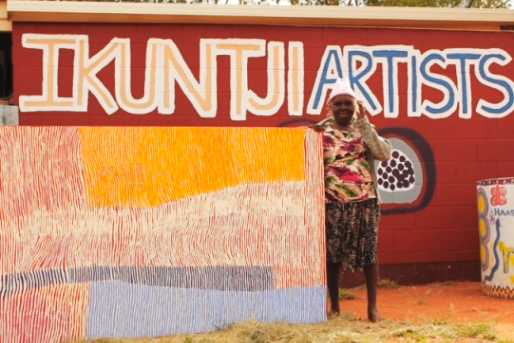
Ikuntji Artists
Location: 230 kms west of Alice Springs
Region: Central Desert, Northern Territory
Iltja Ntjarra / Many Hands Art Centre is proudly Aboriginal owned and directed. It is the home of the Namatjira watercolour artists. The Art Centre was established by Ngurratjuta/Pmara Ntjarra Aboriginal Corporation and started operating in 2004, as a not-for-profit Art Centre to provide a place for Arrernte Artists to come together to paint, share and learn new techniques and ideas. The Art Centre is strongly committed to improving economic participation of Aboriginal people and maintaining cultural heritage.
Iltja Ntjarra has a special focus on supporting the ‘Hermannsburg School’ style watercolour artists, who continue to paint in the tradition of their grandfather and relative, Albert Namatjira, arguably one of Australia’s most famous artists of the 20th century. Albert Namatjira taught his children to follow in his unique style, who have since passed this knowledge on to their children, which has resonated in a legacy of watercolour artists in the Central Desert region. By continuing his legacy, these artists sustain an important piece of living history.
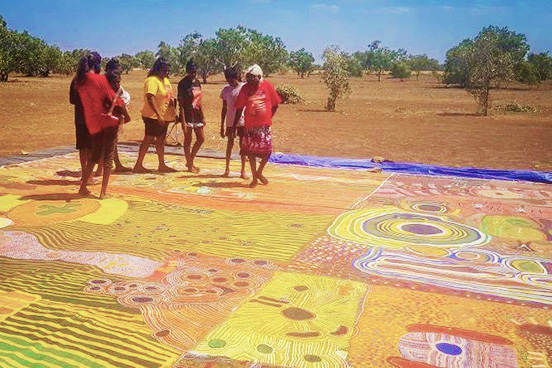
Mangkaja Arts
Location: Fitzroy Crossing
Region: Kimberley, Western Australia
Mangkaja Arts is located in the centre of Fitzroy Crossing on Highway 1, in the south-east of the Kimberley. The region is dominated by the Fitzroy River with its twenty tributaries that flood during the Wet season. The valley has been a major resource for the cattle industry and many groups of Aboriginal people came to the area from surrounding desert areas to join the pastoral industry. Today the people of the Fitzroy Valley area, the Bunaba, Gooniyandi and Nyigina people, are joined by desert people including Walmajarri, Kukaja and Martu people.
Mangkaja is the art centre for all Aboriginal groups in the town and surrounding regions. It emerged in 1993 from the Karriyili Adult Education Centre which formed in 1981. The area has a history of combining literacy with arts practice, as a way for Aboriginal people to tell their stories as part of the broader history of the Kimberley region. Its prominent artists come from all the language groups and include Butcher Cheryl, Peter Skipper, Paji Honeychild, Stumpy Brown, Spider Snell, Jimmy Nerimah and Cory Surprise. David Downs and Jimmy Pike also worked at the centre while maintaining an independent artistic path.
The paintings from Mangkaja Arts are distinguished by their use of bright colour. Throughout the 1990s the artists worked on Arches paper rather than canvas, and they used acrylic paint in the manner of watercolour as it soaked into the paper. This combination of strong colour and wet on wet blending of colour led to a distinctive style that was later translated onto canvas. Many artists also painted in a landscape style, showing waterholes, trees and sandhills, seen from a high vantage point but not entirely like the aerial views more typical of the Western Desert.
The styles of painting are as varied as the many language groups of the artists. The art centre has a gallery to view works and studio spaces for the artists. Artists working through Mangkaja Arts produced the enormous 10-metre x 8-metre Ngurrara canvas painting in 1997, which traditional owners of the Great Sandy Desert presented as part of their statement for Native Title consideration. The painting was later exhibited at the National Museum of Australia in 2008.
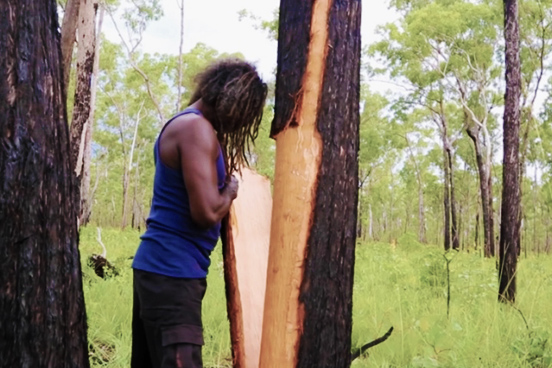
Maningrida Arts
Location: 500kms east of Darwin
Region: Western Arnhem Land, Northern Territory
Maningrida community is on the north coast of Australia in Arnhem Land at the mouth of the Liverpool River facing the Arafura Sea. It is on homelands for Kunibidji people who have strong connections to neighbouring language groups through kinship and ceremony. Maningrida serves a large number of outstations and homeland centres, which are part of its network of family groups, spread across 7,000 sq km and including 100 clan estates. About 3,000 people use the township at Maningrida as their central base.
The community at Maningrida was set up in the 1950s first as a ration station, then as a permanent settlement in 1957. It was to be a centre for Aboriginal people from Blyth and Liverpool Rivers regions who had begun moving from the area into Darwin. Patrols were active in encouraging people to move to the community, which grew steadily over coming years.
Maningrida Arts and Culture centre was established in 1973, which makes it one of the longest running Aboriginal art centres in Australia. Its artists come from many different language groups and create works in ochre painting, bark painting, wood carving, fibre weaving and printmaking. The artists use many natural materials from their country including bush dyes, ochres, tree bark and grass fibre, and create traditional artefacts like fish traps and Lorrkon poles.
Significant artists from Maningrida include John Bulunbulun, Peter Marralwanga, England Banggala, John Mawurndjul, Owen Yalandja, Jack Wunuwun, and Samuel Namundja.
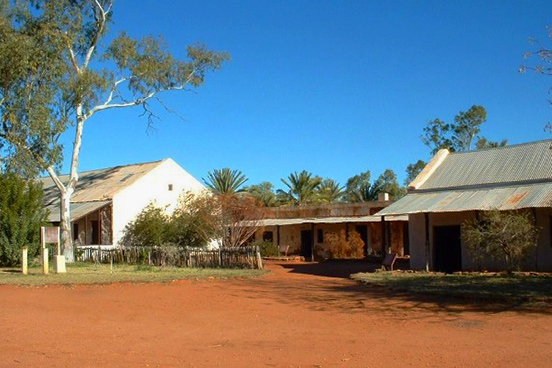
Many Hands Art Centre
Location: Alice Springs
Region: Central Desert, Northern Territory
Many Hands Art Centre was established in 2004 and supports artists in Alice Springs including people from the Town Camps and from settlements further out of town. One of the main groups are Arrernte (Aranda) people from Hermannsburg, about 125 km west of Alice Springs. Many Hands represents a strong group of watercolour painters who work in the style established by Albert Namatjira in the late 1930s through to the 1950s. These artists named the ‘Hermannsburg School’ continue to paint landscape works of the West MacDonnell Ranges and dramatic locations around Hermannsburg settlement made famous by Albert Namatjira. The Namatjira family recently celebrated the return of the copyright estate for the work of Albert Namatjira after many years of negotiation.
The art centre is now called Iltja Ntjarra Many Hands after restructure in 2016. Its artists include Ivy Pereroultja, Gloria Pannka, Mervyn Rubuntja, Elton Wirri and Vanessa Inkamala.
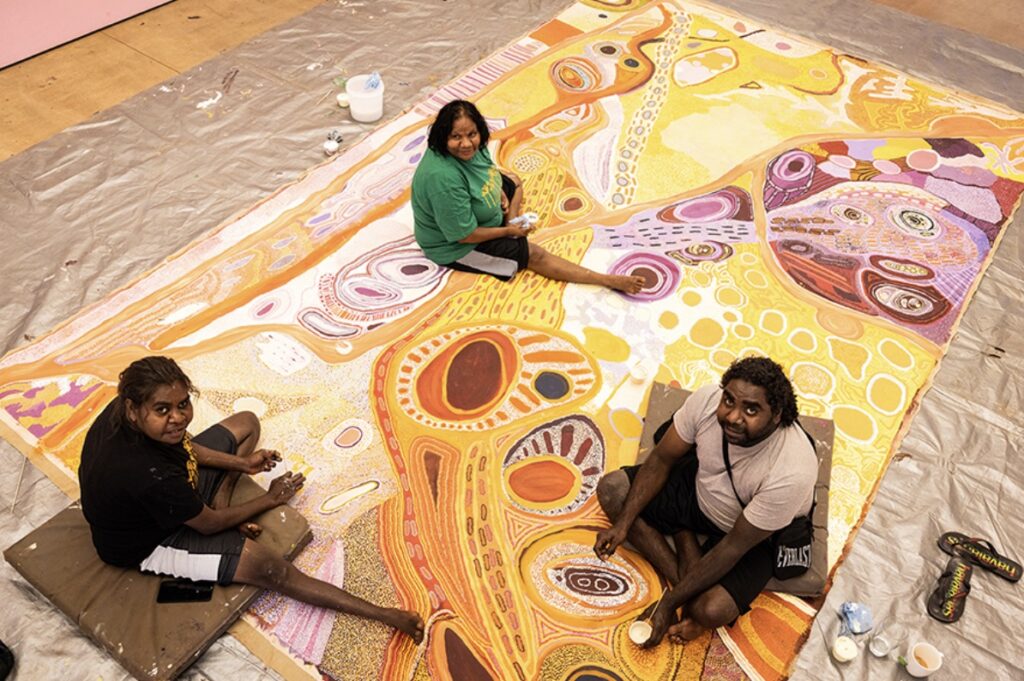
Martumili Artists
Location: Newman
Region: Pilbara, Western Australia
Established in 2006, Matumili Artists is located in Newman, and represents Martu people living in the communities of Parnpajinya (Newman), Jigalong, Parnngurr, Punmu, Kunawarritji, Irrungadji and Warralong.
Traditional custodians of large parts of the Great Sandy, Little Sandy and Gibson Deserts as well as the Karlamilyi (Rudall River) area, many Martu artists have close relationships with established artists amongst Yulparija, Kukatja and other Western Desert peoples.
Martumili Artists work with new and established artists including painters, working in acrylics and oils, as well as weavers coiling baskets and sculptors working in wood, grass and wool. Martumili Artists use accountable, best practice systems like the Indigenous Art Code. This ensures that artworks sold by Martumili Artists carry appropriate cultural authority and that the stories are properly documented.
Artists Profiles:
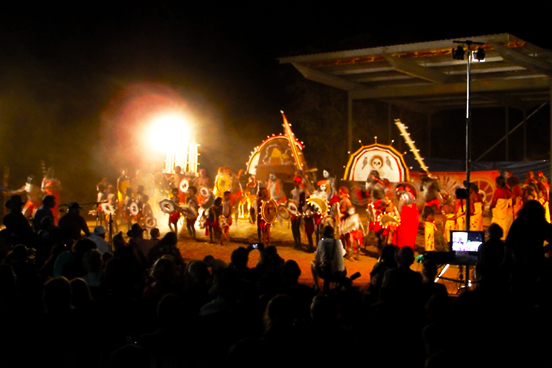
Mowanjum Art Centre
Location: Gibb River Rd, Derby
Region: Kimberley, Western Australia
Mowanjum Aboriginal Art and Culture Centre is 10 km from Derby, near the turnoff on the Gibb River Road. The art centre itself is an impressive building, built to resemble the head of the Wandjina spirit when seen from the air. The artists from the local community are from three West Kimberley language groups, the Worrorra, Ngarinyin and Wunumbal people.
The artwork from Mowanjum Art centre pays tribute to the rich rock art sites on country of the local people. The sites stretch along the coastal region to Kalumburu in the north and inland along the Gibb River Road. The sites are dominated by the Wandjina image, the spiritual creator and bringer of the seasonal rains and regeneration of the Wet season. The Gyorn Gyorn (Bradshaw) figures are found associated with many of these sites, and these date back beyond the last ice age, making them amongst the oldest art images to be found.
Artists at Mowanjum continue this tradition, painting both the Wandjina and Gyorn Gyorn figures
as works on canvas. The ceremonial traditions are also maintained, and each year in July the art centre hosts the Mowanjum Festival where dancers and singers from the region perform in ceremonial events. The art centre has a gallery where mostly smaller works are on display, along with carved boab nuts and limited edition prints.
Senior artists include Donny Woolagoodja, Gordon Barunga, Mildred Mungulu and Alison Burgu, while next generation artists include Leah Umbagai and Kirsty Burgu. The art centre is accessible from the highway and is open daily during the Dry season, May to October.
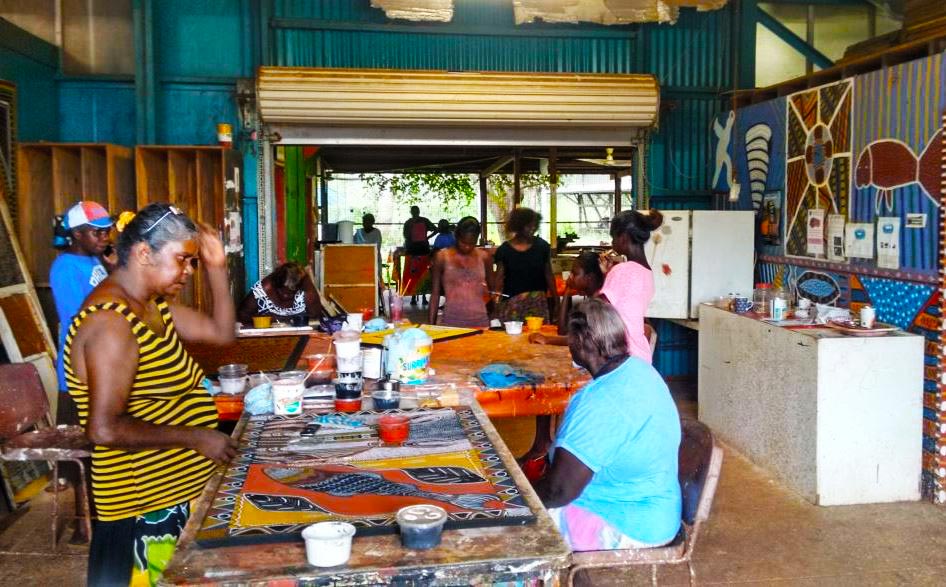
Munupi Arts and Crafts
Location: Melville Island, Timor Sea
Region: Western Arnhem Land, Northern Territory
Munupi Arts and Crafts is one of three arts centres in the Tiwi Islands, located in the Timor Sea about 80 kms north of Darwin. Munupi is in Melville Island at Pirlangimpi community, also called Garden Point, and was formed in 1990 by incorporating two existing centres, Pirlangimpi Pottery and Yikikini Women’s Centre.
Munupi artists work in a wide range of mediums including ochre on canvas, ceramics, fibre weaving, wood carving, etching and screenprints, printed fabrics and textiles. The artists draw on Tiwi stories and culture as well as the natural environment of the tropical island. Munupi artists’ works are often recognisable by the ornate patterns taken from traditional ceremonial painting that are created in layers of ochre colours. These designs are associated with Pukamani and Kulama ceremonies and were applied to Tutini poles, to headdresses and armlets, and to body paintings on ritual participants.
Practicing artists include Susan Wanji Wanji, Alison Puruntatameri, Maria Josette Orsto, Karina Coombes, Lisa Warlapinni, Cornelia Tipuamantumirri, Shirley Puruntatameri, Theresa Burak and Reppie Anne Papajua.
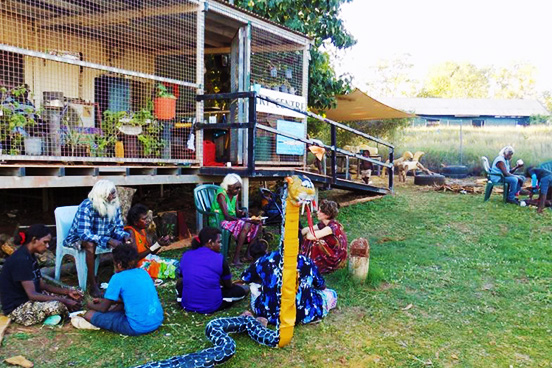
Ngukurr Arts
Location: Roper River
Region: south-east Arnhem Land, Northern Territory
Ngukurr Arts evolved at the Roper River mission which had developed a local Aboriginal management in 1968 after 60 years as a mission settlement. Its distinctive arts practice emerged in 1987 when the first exhibitions of Ngukurr artists were presented in Darwin.
The style of painting reflects the rich landscape of the region around the Roper River. Artists like Willie Gudapi painted the billabongs with their abundant wildlife and food resources. Ginger Riley painted the creation forces of the country and Djambu Barra Barra and Amy Johnson painted the country and the large food animals that were traditionally shared out after a successful hunt. Gertie Huddleston and Angelina George painted the landscape including the way it was farmed and managed by the people. Barney Ellaga abstracted the country into blocks of merging colour.
The style of painting from Ngukurr remains quite contemporary and figurative. It encompasses stories of modern life as well as references to traditional practices. Given that the community has nine different language groups living in the one settlement, the art style reflects the diversity of the artists lives.
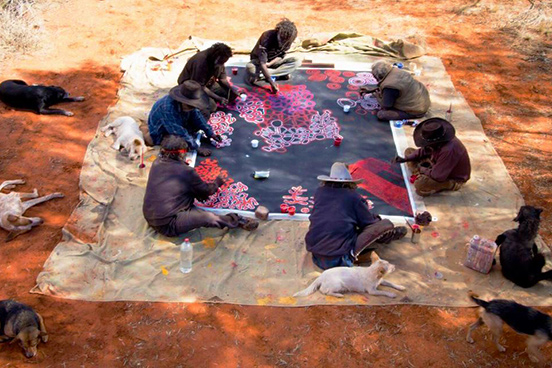
Spinifex Arts Project
Location: Tjuntjuntjara, Pitjantjatjara Lands
Region: Great Victoria Desert, Western Australia
Spinifex Arts Project began in 1997 to assist the Spinifex people who had returned to their ancestral lands to establish as part of the Native Title aspirations of Pitjantjatjara people of the Great Victoria Desert. Moved off their ancestral homelands by the disruption of the missile and nuclear tests of the 1950s, they had determined to relocate to the places and sites their forefathers knew.
Spinifex people successfully received Native title rights to their lands in the year 2000. They opted to donate ten paintings that showed their family links to Country to the Museum of Western Australia.
The artists have continued to paint and document their country as part of the community culture and their works are in major collections including the British Museum in London.
The paintings strongly focus on waterholes and Tjukurpa Songlines found on the birthplace country of the senior artists. Paintings use strong colour to delineate Country and its Creation era mythological features. Senior artists include Simon Hogan, Roy Underwood, Lennard Walker, Ian Rictor, Tjaruwa Woods, Myrtle Pennington, Ngalbingka Simms and Kathleen Donnegan.
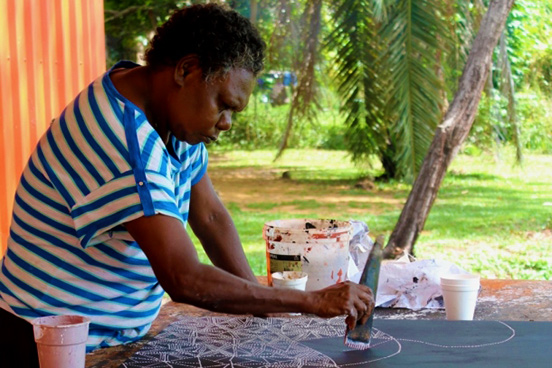
Tiwi Designs
Location: Bathurst Island, Timor Sea
Region: Western Arnhem Land, Northern Territory
Tiwi Designs was established in 1968 at Nguiu settlement on Bathurst Island, 80 km to the north of Darwin. Starting with carving woodblock prints, the artists then transferred the designs onto silkscreens for printing designs onto textiles. The community at Nguiu has a population of about 1500 and about 100 artists work at the art centre.
Artists at Tiwi Designs produce artworks in mediums of ochre painting, wood carving, ceramics, sculpture and screen-printed fabrics. The art is an expression of identity, recognisable in the culturally distinct patterns created by different groups of artists. The style of art produced comes from the ceremonial practices and cultural traditions of the Tiwi Islands.
Ceremonies remain an important part of Tiwi society upheld by the long-standing oral traditions. The two central events performed are the Pukumani funeral ceremony and the annual Kulama ceremony. The Pukamani, or Tutini, burial poles are a unique aspect of Tiwi Islands. Visitors in the early 1900s made a record of elaborate body decorations and face painting, and headdresses, mourning rings and armlets being worn by dancers at large Tiwi ceremonies. Tiwi people value the forms of personal creativity expressed through dance, song, and visual arts.
Practicing artists include Bede Tungatalum, Maria Jostte Orsto, Romolo Tipiloura, John Tipungwuti, Immaculata Tipiloura and Michael Munkara.
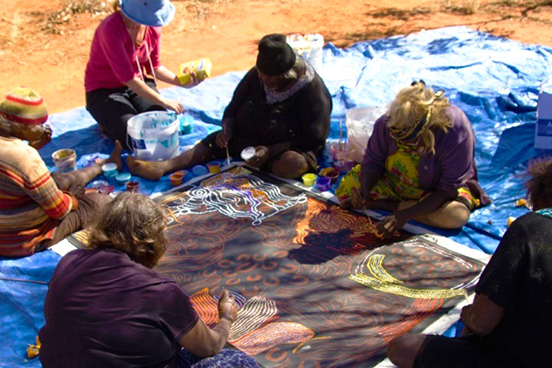
Warakurna Artists
Location: Ngaanyatjarra Pitjantjatjara Yankunytjatjara Lands
Region: Western Desert, Western Australia
Warakurna Artists opened its arts centre in 2005 to serve its community of about 180 people living on NPY Lands near the Western Australia and Northern Territory borders. The major art force in the area began at the community of Warburton in the 1990s and through its influence spread to five of the smaller neighbouring communities.
Warakurna had been established in the 1970s to assist Aboriginal people from the region to locate closer to their ancestral lands. Its location on the Great Central Road near Giles weather station provided access roads and a reliable water supply.
Important artists who have worked at Warakurna art centre include Myra Yurtiwa Cook, Carol Maanyatja Golding, Tommy Mitchell, Tjapartji Bates, Neville McArthur, Tjunka Lewis and Eunice Yunurupa Porter. Younger artists like Cynthia Burke carry on the traditions of their elders. The art style follows the themes of the Western Desert, employing vibrant colours to highlight the Tjukurrpa or creation stories of the land, as well as contemporary stories.
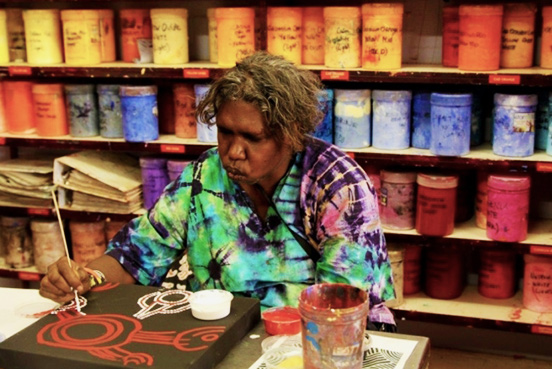
Warlukurlangu Artists
Location: Yuendumu
Region: Tanami Road, Northern Territory
Warlukurlangu Artists is one of the largest Aboriginal art centres in Central Australia, located at the community of Yuendumu, 280 km north-west of Alice Springs. It was formed in 1985 and its cultural roots go back to the beginning of the desert art movement at Papunya. In 1971 the community established a Men’s Museum to house significant cultural materials and knowledge.
https://japingkaaboriginalart.com/articles/yuendumu-mens-museum/
Yuendumu is a large community by Central Desert standards and home to a strong group of Warlpiri people. The community was split in 1949 to ease the demands of a growing population and the new community of Lajamanu was formed at Hookers Creek, 600 km to the north.
In the 1980s senior Yuendumu artists painted Jukurrpa or Dreaming stories on the doors of the school as a statement of cultural integrity and continuity. Warlukurlangu Artists Association was formed out of local demand for arts access and in 1985 began to market the works of hundreds of artists painting in the community. The subject of the artworks remains constantly about the Jukurrpa or Dreaming stories pertinent to each family and skin group.
Warlukurlangu Artists have moved steadily from using the earth colours of the early decades to using a full palette of artists colours. Early artists include Maggie Watson Napangardi (1925-2004) and later her sister Judy Watson Napangardi (1935-2016) who both introduced vibrant colour into their artworks. Other senior artists from Yuendumu include Paddy Japaltjarri Sims, Liddy Napanangka Walker and Alma Nungarrayi Granites.
Warlukurlangu Artists has been a highly successful art centre contributing to thousands of exhibitions for the 160 artists who currently paint for the art centre. In recent years the outstation at Nyirripi has been included in the services of the art centre. Exhibitions extend to international venues and public institutions as well as leading galleries throughout Australia.
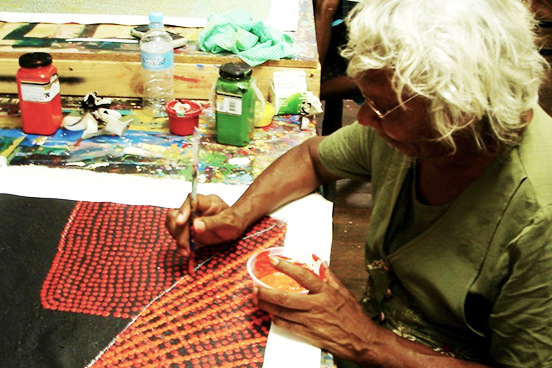
Yinjaa-Barni Art
Location: Roebourne
Region: Pilbara, Western Australia
Yinjaa-Barni Art is located in Dalgety House, a heritage building in the main street of the Pilbara town of Roebourne, near the mining port and towns of Dampier and Karrartha. The artists at Yinjaa-Barni are from Millstream Tablelands and Fortescue River area, inland and to the south-east of Roebourne. This area stretches from the Hamersley Range to the Chichester escarpment, centred around the Yarnda Nyirranha, or Fortescue River.
Yinjaa-Barni Art centre formed in 2007 out of art projects held over the previous five years in the area at Cossack and Roebourne, with the name meaning ‘staying together’. The artists that have gathered here include Clifton Mack, Marlene Harold, Maudie Jerrold, sisters Allery Sandy, Aileen Sandy, Melissa Sandy, Pansy Sambo and Wendy Darby.
The style of painting at Yinjaa-Barni is varied, using contemporary techniques with layers of colour and occasional texture to build up paint surfaces. Artists use elements of the natural world and the changing seasons as their subject. Reference is also made to Marrga, the Creation time in Yindjibarndi culture, which continues to be part of the regeneration of the country after rain.
Yinjaa-Barni artists exhibit mostly in Perth and Sydney, with special contributions to feature exhibitions held by mining companies that have built sponsoring relationships with the art centre. Yinjaa-Barni artists express those things close to their hearts – their country, culture and the native bush plants of the region. Through painting and story-telling they seek to pass on their knowledge to younger generations, including about the plants and their traditional uses.


